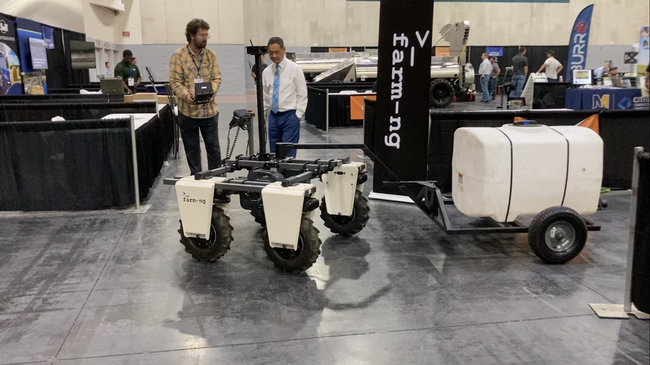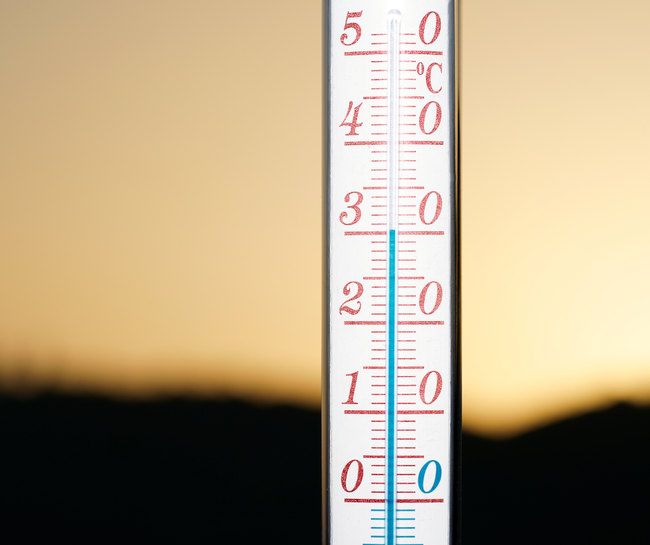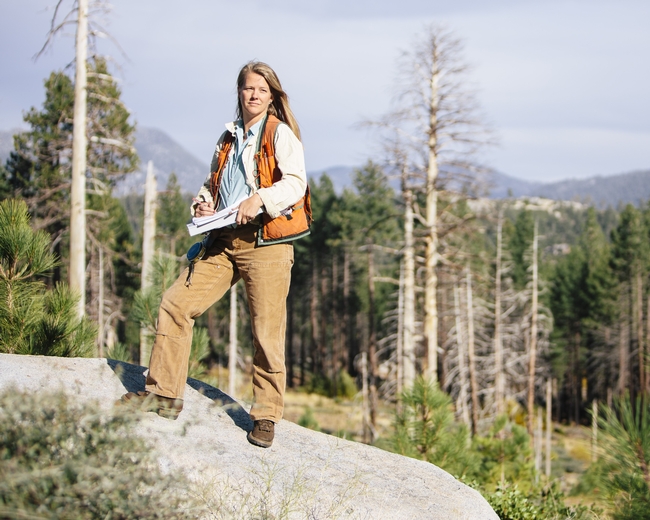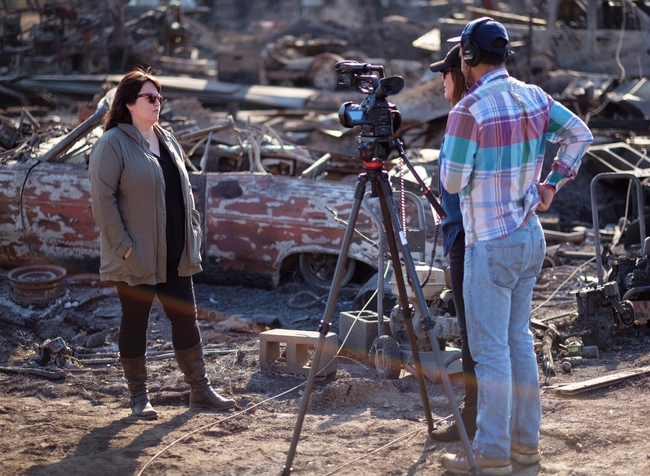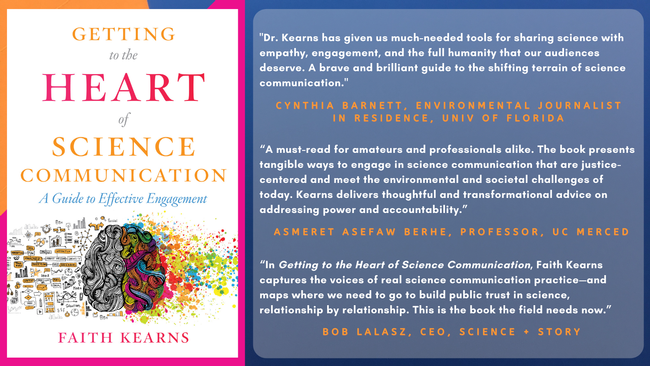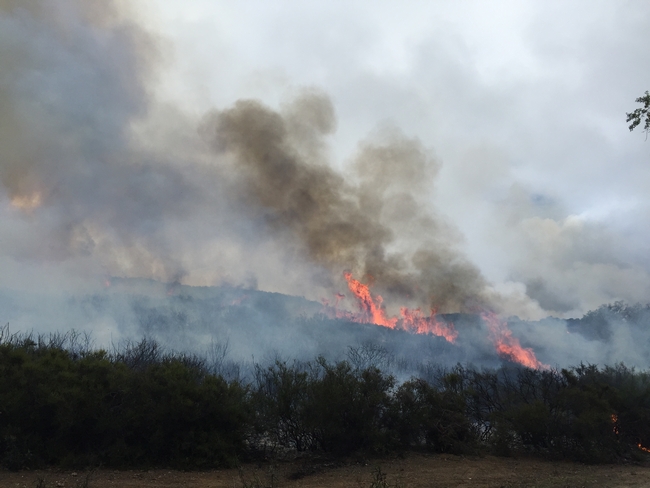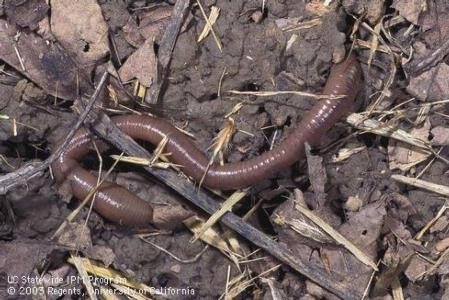Posts Tagged: climate change
UC ANR receives $1 million for VINE Climate Smart Agrifood Innovation Program
University of California Agriculture and Natural Resources (UC ANR) has been awarded a $1 million UC Climate Action Innovation & Entrepreneurship grant for its VINE Climate Smart Agrifood Innovation Program. The VINE, a UC ANR program advancing sustainable agriculture and food innovation, will use the grant to develop new technologies and techniques that help California farmers adapt to climate change.
"Expanded programming from The VINE will improve UC ANR's overall ability to serve our mission of improving the lives of all Californians," said Glenda Humiston, UC vice president for agriculture and natural resources.
California's agricultural sector is the largest in the United States, producing over 400 crops that account for 25% of the nation's food production and 40% of its fruits, vegetables and tree nuts.
However, climate change is expected to have a significant impact on the productivity and resilience of California's working landscapes. Higher temperatures and changing precipitation patterns are projected to increase water demand for crops and create a more limited growing season that will produce lower yields in some crops. Additionally, climate change may increase weed growth and insect damage, leading to higher uses of herbicides and pesticides.
“We are thrilled to receive the UC Climate Action Innovation & Entrepreneurship Award,” said Gabe Youtsey, UC ANR's chief innovation officer. “With this grant, we will be able to support even more entrepreneurs and innovators in developing climate-resilient solutions for California's agriculture and food systems."
"Our ultimate goal is to build a bioeconomy in California's food valleys that rivals Silicon Valley in size and importance to the future U.S. economy, while also addressing urgent climate crises and advancing equity for underserved populations," Youtsey said.
The VINE Climate Smart Agrifood Innovation Program is designed to identify, commercialize, and scale science and technology breakthroughs that make food production more sustainable. The VINE team has already supported entrepreneurs in the areas of controlled environment agriculture, precision agriculture, robotics, biologicals, climate-resilient crops, livestock health, and other topics that have direct or indirect mitigating effects on climate change.
The UC Climate Action grant will enable The VINE program to expand its support for startups and entrepreneurs developing climate-resilient solutions for California's food system. The program will include the creation of a VINE Climate Solutions Seed Fund, which will provide project support for testing, trialing and demonstrating agrifood technology products or services to support commercial expansion.
The VINE Navigator Service will be expanded to provide matchmaking, mentoring, talent identification, finance connections and technical assistance to entrepreneurs from UC campuses, across California, or startups around the globe that have climate solutions in the agrifood sector.
An example of this work is farm-ng, a farm robotics start-up based in Watsonville that The VINE has been advising. With the networking opportunities facilitated by The VINE, farm-ng was able to secure 20 new customers, generating an estimated $500,000 in revenue. The VINE's involvement also enabled farm-ng to establish a professional manufacturing facility and employ local talent from disadvantaged communities.
The award is part of a historic $185 million partnership between UC and the state of California to tackle the climate crisis, from developing new methods for carbon capture to creating innovative coping strategies for drought, wildfire and other impacts of a warming planet.
The VINE
The VINE program aims to create a next-generation agrifood technology bioeconomy in California's food valleys to promote sustainable economic growth, address climate crises, and advance equity for underserved regions and populations. The VINE team will work closely with local and regional partners to identify key industry-driven gaps and opportunities across the food system and provide critical support to startups and entrepreneurs developing new solutions for climate mitigation and adaptation.
For more information, please visit The VINE website: thevine.io.
Disaster resources available to prepare for heat, wildfire, power outages, quakes
September is National Preparedness Month, designated to encourage disaster and emergency readiness. To help Californians prepare for extreme heat, earthquakes, public safety power shutoffs and wildfire, University of California Cooperative Extension has created a disaster preparedness website organized for quick access to critical information.
The website https://ucanr.edu/Disaster contains fact sheets with tips for getting prepared.
“Unfortunately, with a warming climate, we are facing more and more extreme climate-related events such as heat waves, wildfires, power shutoffs and storms. All Californians need to step up their preparedness efforts to be ready to meet this more uncertain future,” said Susan Kocher, UC Cooperative Extension forestry advisor, who co-authored the disaster preparedness resources for the website.
Extreme heat
The fact sheet for extreme heat events offers suggestions for avoiding heat exposure, such as identifying nearby cooling centers and covering windows to keep heat out. It also suggests things to do during hot weather such as staying hydrated, taking cool showers and keeping pets indoors. It describes symptoms of heat-related illnesses, which can have serious health effects.
Public Safety Power Shutoff
During extreme weather events, electrical power in high fire-threat areas may be shut off to prevent sparking. This precaution is known as a Public Safety Power Shutoff. A PSPS is most likely to occur from May to November, when conditions are the hottest and driest.
UC Cooperative Extension recommends signing up to receive PSPS alerts from your energy company. Experts also advise making a plan for medications that need to be refrigerated or medical devices that require power. To prevent foodborne illness, they offer suggestions for ensuring food safety during and after a power outage.
Wildfire and smoke
Wildfire smoke can harm your health. During wildfires, UC Cooperative Extension recommends wearing an N95 outdoors to reduce smoke exposure and taking steps to prevent smoke from entering buildings. To reduce wildfire risk, the website describes methods of removing flammable vegetation around homes.
Earthquakes
UC Cooperative Extension offers safety tips for before, during and after an earthquake. Identifying the safest place in your home during an earthquake in advance is helpful. For example, doorways are not the safest place to be in modern homes. Experts recommend crawling under a sturdy desk or table, while avoiding areas next to windows, beneath ceiling fixtures or near large items that may fall during an earthquake.
The website also offers resources on drought, food safety after a fire, and wildfire preparedness and recovery.
In 2020 and 2021, Cooperative Extension researchers from around the country held listening sessions with community members who had experienced extreme weather events and other types of disasters to learn what had worked well, what had not, and how communities could be strengthened.
In response, these disaster resources were developed by Kocher, UC Davis undergraduate student Caydee Schweitzer, Tracy Schohr, UC Cooperative Extension livestock and natural resource advisor, and Vikram Koundinya, UC Cooperative Extension evaluation specialist. The group plans to add fact sheets on more disaster topics in the future.
This project was funded by a USDA National Institute of Food and Agriculture Renewable Resources Extension Act grant.
MEDIA CONTACT: Susan Kocher, UC Cooperative Extension forestry advisor, sdkocher@ucanr.edu
Communicating about climate crisis and other scientific issues requires more than facts
New book offers advice for discussing misconceptions and oversimplifications
Research can inform people to take appropriate action to solve problems, but effectively communicating is key. Faith Kearns, who works on emotional and contentious water-related issues such as climate change, drought and wildfire, has learned firsthand that the way scientists communicate can deeply affect people and communities.
Kearns, an academic coordinator for the California Institute for Water Resources at University of California Agriculture and Natural Resources, has written about what she has learned in 25 years of practice in a new book, Getting to the Heart of Science Communication: A Guide to Effective Engagement from Island Press. The book includes on-the-ground experiences of many science communicators, including those working in Cooperative Extension.
“The book offers an on-the-ground perspective on communicating emotional and contentious topics and is filled with concrete examples from practitioners, which is different from many science communication books written by journalists or researchers,” Kearns said. “It is centered around practical tools like relating, listening, working with conflict, and understanding trauma, all with an eye toward equity and justice.”
Among the many issues addressed in the book – ranging from food security to disasters – climate change is one of the biggest. Meteorologist and climate journalist Eric Holthaus notes in the foreword that giving people scientific facts isn't convincing many people that there is a climate crisis, much less solving the climate emergency. “This crisis is getting worse not because of a deficit of information, after all, but because of a deficit of action,” writes Holthaus.
Grist journalist Kate Yoder wrote, “For a long time, scientists have relied on a ‘deficit' model of communication. The idea is that if people are given enough facts and data about, say, climate change, then they'd accept the science— in a logical, rational way — and decide to take action. This idea isn't necessarily wrong, but it ignores the messiness of the world and the role that emotions play in guiding decisions.”
Kearns begins the book with a personal anecdote that changed the way she thought about science communication. After she and her colleagues gave a presentation on wildfire preparation to residents in Mendocino County, an emotional audience member explained to Kearns that he had labored to keep a recent wildfire from consuming his property and the way the researchers had presented their information without attention to the fact that a fire had just burned through the area had been re-traumatizing.
“Many communicators, including myself, have neglected other pieces of communicating that don't have to do with providing information,” Kearns said. “It's so important to know who you are in conversation with and what they've been through. Their history, communities, and personal experiences impact how they will receive scientific information. One of the most important skills you can have as a science communicator is to be able to listen well.”
Jonathan Wai reviewed Kearns' book in Science. He wrote: “The book offers a view from the front lines of science communication, profiling practitioners who explain their journeys and share stories of relationship building and community engagement. Framing herself as a scientist turned science communicator, Kearns describe her vision for the future of the field, one in which relational communication is fundamental.”
Kearns acknowledges in the preface that a single book cannot be all things to all people. “My hope is that I can fairly treat the argument that emotion, conflict, and power struggles are already present in science communication and engagement work and that ignoring them is counterproductive,” she wrote.
Getting to the Heart of Science Communication is written for science communicators and scientists working at research institutions, government agencies, consulting firms or nonprofit organizations. In addition, it will be of interest to those working with scientists including journalists and decision-makers. People interested in science will also find much to consider in this updated view of the science communication landscape.
The 280-page paperback is published by Island Press and can be ordered for $30 (use code HEART for a publisher discount) at https://islandpress.org/books/getting-heart-science-communication and wherever books are sold.
For more about science communication, see Kearns' blog at https://faithkearns.substack.com.
It's not just climate change: Study finds human activity is a major factor driving wildfires
The findings suggest many models of wildfire predictions do not accurately account for anthropogenic factors and may therefore be misleading when identifying the main causes/drivers of wildfires. The newest model proportionately accounts for climate change and human behavioral threats and allows experts to more accurately predict how much land is at risk of burning in California through 2050, which is estimated at more than 7 million acres in the next 25 years.
Climate change affects the severity of the fire season and the amount and type of vegetation on the land, which are major variables in predicting wildfires. However, humans contribute another set of factors that influence wildfires, including where structures are built, and the frequency and location of ignitions from a variety of sources—everything from cigarettes on the highway, to electrical poles that get blown down in Santa Ana winds. As a result of the near-saturation of the landscape, humans are currently responsible for igniting more than 90 percent of the wildfires in California.
“Individuals don't have much control over how climate change will effect wildfires in the future. However, we do have the ability to influence the other half of the equation, those variables that control our impact on the landscape,” said Michal Mann, assistant professor of geography at George Washington University and lead author of the study. “We can reduce our risks by disincentivizing housing development in fire-prone areas, better managing public land, and rethinking the effectiveness of our current firefighting approach.”
The researchers found that by omitting the human influence on California wildfires, they were overstating the influence of climate change. The authors recommend considering climate change and human variables at the same time for future models.
“There is widespread agreement about the importance of climate on wildfire at relatively broad scales. At more local scales, however, you can get the story quite wrong if you don't include human development patterns,” said co-author Max Moritz, UC Cooperative Extension fire ecology specialist whose lab is at the University of California, Berkeley. “This is an important finding about how we model climate change effects, and it also confirms that getting a handle on where and how we build our communities is essential to limiting future losses.”
Between 1999 and 2011, California reported an average of $160 million in annual wildfire-related damages, with nearly 13,000 homes and other structures destroyed in so-called state responsibility areas - fire jurisdictions maintained by California, according to Mann. During this same period, California and the U.S. Forest Service spent more than $5 billion on wildfire suppression.
In a model from 2014 that examined California wildfires' destruction over the last 60 years, Dr. Mann estimated that fire damage will more than triple by mid-century, increasing to nearly half a billion dollars annually. “This information is critical to policymakers, planners, and fire managers, to determine wildfire risks,” he said.
The paper, “Incorporating Anthropogenic Influences into Fire Probability Models: Effects of Human Activity and Climate Change on Fire Activity in California,” published Thursday in PLOS ONE.
Press release written by Emily Grebenstein, George Washington University, emgreb@gwu.edu, 202-994-3087
'Global worming': Earthworms contribute to climate change
Earthworms are long revered for their beneficial role in soil fertility, but with the good comes the bad: they also increase greenhouse gas emissions from soils, according to a study published Feb. 3 in Nature Climate Change by a research team that includes a University of California, Davis, soil scientist.
The team found that earthworms do not, as was suspected, stimulate carbon sequestration in the soil, which helps to reduce greenhouse gas emissions. Instead, they actually increase greenhouse gas emissions through a variety of ways.
"There was a hypothesis that earthworms were having a positive effect on the greenhouse balance, but they don't," said co-author Johan Six, a plant sciences professor at UC Davis during the study who is now a professor at ETH Zurich in Switzerland. "I would never say you have to take out the earthworms because of greenhouse gases. It's just that you cannot give them credit for reducing greenhouse gases."
The scientific team was led by Jan Willen van Groenigen of Wageningen University in the Netherlands, and, along with UC Davis, included colleagues from Trinity College Dublin, and the International Center for Tropical Agriculture in Cali, Colombia.
The team gathered all relevant published research to date: 57 different experiments.
The research team then employed a statistical technique called meta-analysis to discern overall patterns in the data.
They found that the presence of earthworms increased nitrous oxide emissions from soil by 42 percent and carbon dioxide emissions from soil by 33 percent. But they found no indications that earthworms affect soil organic carbon stocks -- the carbon stored within the soil.
According to the researchers, earthworms likely increase greenhouse gas emissions several ways: they mix organic plant residues in the soil, which may increase decomposition and carbon dioxide emissions; the earthworm gut acts as a microbial incubator, boosting the activity of nitrous oxide-producing microbes; and the earthworms, by burrowing through the soil, make it easier for greenhouse gases in the soil to escape into the atmosphere.
Small changes in soil greenhouse gas dynamics can have important repercussions for global warming, the researchers said. But lead author Ingrid Lubbers from Wageningen University said it is not yet clear to what extent the effects of earthworms on plant growth may negate earthworm-induced increases in greenhouse gas emissions.
"Our literature search also pointed out a large gap in the published studies," Lubbers said. "We need more experiments that include growing plants, as well as more long-term studies and more field studies before we can decide to what extent global worming leads to global warming."


